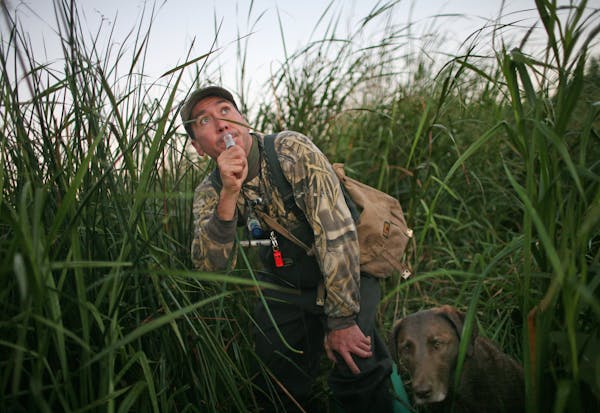MARSHALL, MINN. – Fixing Minnesota's pheasant problem involves improving or adding habitat, and that is a complex and expensive proposition. After six hours of discussion and debate, the 300 people at the Minnesota Pheasant Summit here Saturday came up with about two dozen ideas.
Recommendations
• Enforce existing laws regarding waterway buffers, roadside ditches and easements. A report earlier this year said four-fifths of the cropland that adjoins streams and rivers of southern Minnesota is missing at least some of the legally required 50-foot buffer strips. Gov. Mark Dayton said legislative action might be needed.
• Increase bonding funds for state wildlife management area acquisition. Those traditional funding dollars have dried up since the Legacy Amendment passed, even though Legacy money isn't supposed to supplant traditional spending. "I'm going to propose a bonding bill,'' Dayton said.
• Target funding to specific high-quality habitat areas through state, local and federal cost-share programs.
• Federal farm policy drives agricultural conservation efforts, but the group focused on what Minnesota can do: Increase state and local funding. But, Dayton said earlier in the day: "It can't be just about getting more money. It has to be about spending the money we have more wisely and strategically.''
• Create competitive compensation for landowners for long-term, perpetual conservation practices.
Quotes
• "Why should someone in Minneapolis who doesn't hunt care about this? Because the pheasant is the canary in a coal mine — it represents the health of the landscape.'' — DNR Commissioner Tom Landwehr.
• "I've done my part to preserve pheasants — I haven't gotten a single one in the last four Governor's Openers.'' — Gov. Mark Dayton.
• "This is not a political issue. This is about a way of life in Minnesota. We need to move this forward and get some results.'' — Dayton
• "We're not here to have more feathered targets, and we're not here to bash farmers. We need to find common ground.'' — Ron Schara, host of Minnesota Bound and emcee of the summit.
Who attended?
Of the 300 people, about 50 were DNR employees. But attendees included representatives from many of the state's conservation groups. Some farmers and those representing the agricultural industry were present, too. Also there: Dan Whitney, president of the Minnesota Honey Producers Association, underscoring that good pollinator habitat benefits all wildlife.
Only one legislator attended the summit, an absence noted by Tom Kalahar of Olivia, who works for the Renville County Soil and Water Conservation District. "It's disheartening,'' he said. "All of the legislators from the region should have been here.''
The mood
Attendees broke into small work groups in the afternoon. Tabor Hoek, private lands coordinator for the state Board of Water and Soil Resources, helped a group of two dozen participants, including some landowners, develop ideas for protecting existing habitat on private lands.
They were enthusiastic, offering 30-some ideas. Other groups were similarly enthused.
"There's optimism,'' Hoek said. "People wouldn't have come here if they were doom and gloom.''
Several speakers emphasized that the summit wasn't intended to be anti-agriculture.
"We understand our farmers need to fuel and feed the nation,'' said Howard Vincent, CEO of Pheasants Forever. "Ninety-five percent of our conservation efforts take place on private land.''
An ag perspective
Doug Peterson, president of the Minnesota Farmers Union, which represents 14,000 farm families, was among agriculture industry representatives.
"We're the resource owners,'' he said. "It's time to stop pointing fingers. If we agree we need a state initiative for habitat for pheasants, wildlife, birds, pollinators and clean water, then it's time for a policy that allows farmers to be part of the solution.''
But he said landowners can't be expected to give up income to implement conservation. Peterson, who has a 309-acre farm in Lac qui Parle County, said he has a 15-acre parcel enrolled in the federal Conservation Reserve Program. But his payments are $100 an acre less than he could receive leasing the land for production.
"It's not big money, but it's not small money,'' he said.
Online survey ideas
Some 742 people completed a nonscientific survey on the DNR's website before the summit. The results:
• The biggest challenge facing pheasants: 71 percent said loss of nesting and wintering habitat.
• The most important thing to do to ensure long-term health of the population: 37 percent said create more nesting habitat, 18 percent said preserve existing habitat, and 14 percent said create more winter habitat.
• The most important thing to ensure the future of pheasant hunting: 34 percent said acquire more public hunting land, 29 percent said increase pheasant numbers and 17 percent said expand the walk-in access program.
• The biggest threat to pheasant hunting: 52 percent said not enough free time to hunt, 32 percent said lack of places to hunt.
What next?
The DNR plans to refine summit suggestions and develop a plan for accelerated pheasant habitat, which will be brought to the annual DNR "roundtable" meetings with citizens on Jan. 16. The intent is to get reaction from roundtable attendees. The invitation-only roundtable will be in Brooklyn Park.
Landwehr said the DNR will develop metrics and goals that can be evaluated in a "report card'' that will be brought to future roundtables.
"We'll measure our progress over the next four years,'' he said.
Brayan Bello allows 1 hit in 6 innings as Red Sox breeze past Pirates 8-1
Elly De La Cruz slugs 3-run HR and Nick Lodolo works 6 strong innings as Reds beat Angels 7-1
Nelly Korda 1 shot back through 36 holes at Chevron Championship as she chases 5th straight victory

Wild rumblings: Gustavsson wants to return, Faber played despite broken ribs
![Minnesota Twins pitcher Jhoan Duran (59) in the ninth inning Tuesday, August 15, 2023, Target Field in Minneapolis, Minn. ] CARLOS GONZALEZ • carlos](https://arc.stimg.co/startribunemedia/NWLT5CNXGTRZA6KVTMIPSOG3KI.jpg?h=91&w=145&fit=crop&bg=999&crop=faces)
